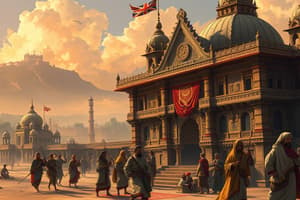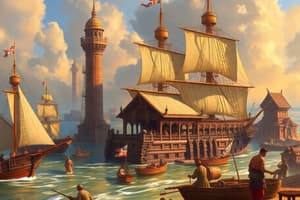Podcast
Questions and Answers
What was the most significant consequence of the Battles of Plassey (1757) and Buxar (1764) in the context of British expansion in India?
What was the most significant consequence of the Battles of Plassey (1757) and Buxar (1764) in the context of British expansion in India?
- They led to the immediate annexation of all Indian states by the British Crown.
- They triggered the Sanyasi and Fakir Rebellion against the British.
- They resulted in the establishment of a stable alliance between the British and the Mughal Empire.
- They consolidated British control over Bengal and other territories, paving the way for further expansion. (correct)
Which policy, introduced by Lord Cornwallis in 1793, had a profound impact on land revenue systems and agrarian structures in India?
Which policy, introduced by Lord Cornwallis in 1793, had a profound impact on land revenue systems and agrarian structures in India?
- Ryotwari System
- Subsidiary Alliance
- Permanent Settlement (correct)
- Doctrine of Lapse
What was the primary cause of the Revolt of 1857?
What was the primary cause of the Revolt of 1857?
- The introduction of railways.
- The economic prosperity brought by the British.
- The controversial greased cartridges combined with deeper resentment against British rule. (correct)
- The successful integration of Indian soldiers into the British army.
Which reform movement is Swami Dayanand Saraswati most closely associated with?
Which reform movement is Swami Dayanand Saraswati most closely associated with?
How did the Drain Theory, articulated by Dadabhai Naoroji, impact the rise of Indian nationalism?
How did the Drain Theory, articulated by Dadabhai Naoroji, impact the rise of Indian nationalism?
What was the main strategy employed by Mahatma Gandhi in the Indian Independence Movement?
What was the main strategy employed by Mahatma Gandhi in the Indian Independence Movement?
What did the Lahore Resolution of 1940 call for?
What did the Lahore Resolution of 1940 call for?
What was the primary recommendation of the Cabinet Mission Plan of 1946?
What was the primary recommendation of the Cabinet Mission Plan of 1946?
What was the most significant outcome of the Mountbatten Plan of 1947?
What was the most significant outcome of the Mountbatten Plan of 1947?
How did the British economic policies affect Indian industries and handicrafts?
How did the British economic policies affect Indian industries and handicrafts?
Flashcards
Battles of Plassey (1757) and Buxar (1764)
Battles of Plassey (1757) and Buxar (1764)
Consolidated British control over Bengal and other parts of India.
Aligarh Movement
Aligarh Movement
Aimed to modernize Muslim education and society.
Swadeshi Movement
Swadeshi Movement
Promoted indigenous goods and boycotting foreign products.
Satyagraha
Satyagraha
Signup and view all the flashcards
Mountbatten Plan (1947)
Mountbatten Plan (1947)
Signup and view all the flashcards
Radcliffe Line
Radcliffe Line
Signup and view all the flashcards
Social Reforms
Social Reforms
Signup and view all the flashcards
Partition of India
Partition of India
Signup and view all the flashcards
Satya Shodhak Samaj
Satya Shodhak Samaj
Signup and view all the flashcards
End of East India Company's Rule
End of East India Company's Rule
Signup and view all the flashcards
Study Notes
- Modern Indian history spans from 1750 to 1947, encompassing major events like the Freedom Struggle, Colonial Impact, Social Reforms, Partition of India, and the Indian Independence Movement.
Colonial Expansion and Resistance (1750-1857)
- The decline of the Mughal Empire created a power vacuum, enabling the rise of regional powers and facilitating the expansion of the British East India Company.
- Key battles such as Plassey (1757) and Buxar (1764) consolidated British control over Bengal and other parts of India.
- Early resistance movements included:
- Sanyasi and Fakir Rebellion.
- Revolt of Velu Thampi.
- Paika Rebellion in Odisha.
- The Permanent Settlement (1793), introduced by Lord Cornwallis, changed land revenue systems but led to agrarian distress.
- Subsidiary Alliance and Doctrine of Lapse were policies used to annex Indian states.
The Revolt of 1857
- The Revolt of 1857 was triggered by controversial greased cartridges but reflected deeper grievances against British rule.
- Key leaders included:
- Mangal Pandey.
- Rani Lakshmibai.
- Tatya Tope.
- Bahadur Shah Zafar.
- The revolt was suppressed, leading to the end of the East India Company's rule and the direct governance by the British Crown.
Social and Religious Reform Movements
- The 19th century saw significant social and religious reform movements aimed at addressing social evils and promoting modernization.
- Key figures and movements:
- Raja Ram Mohan Roy and the Brahmo Samaj, advocating for the abolition of Sati and promoting modern education.
- Swami Dayanand Saraswati and the Arya Samaj, emphasizing a return to the Vedas and challenging idol worship and caste distinctions.
- Ishwar Chandra Vidyasagar, who championed widow remarriage.
- Jyotirao Phule and the Satya Shodhak Samaj, focused on the upliftment of lower castes.
- The Theosophical Society, promoting universal brotherhood and the study of ancient religions and philosophies.
- Syed Ahmed Khan and the Aligarh Movement, which aimed to modernize Muslim education and society.
Rise of Indian Nationalism
- The Indian National Congress (INC) was founded in 1885 by A.O. Hume, initially focusing on moderate reforms.
- Early nationalists included:
- Dadabhai Naoroji.
- Surendranath Banerjee.
- Gopal Krishna Gokhale.
- The economic critique of British rule, as articulated in the Drain Theory by Dadabhai Naoroji, fueled nationalist sentiments.
- The partition of Bengal in 1905 sparked widespread protests and the Swadeshi Movement, promoting indigenous goods and boycotting foreign products.
Gandhian Era (1915-1947)
- Mahatma Gandhi's arrival in India in 1915 marked a new phase in the independence movement.
- Gandhi introduced Satyagraha, a non-violent method of resistance.
- Key movements led by Gandhi:
- Champaran Satyagraha (1917).
- Kheda Satyagraha (1918).
- Non-Cooperation Movement (1920-1922).
- Civil Disobedience Movement (1930-1934), including the Dandi March.
- Quit India Movement (1942).
- The Government of India Act, 1919 introduced Dyarchy and expanded provincial legislatures.
- The Government of India Act, 1935 granted greater autonomy to provinces and proposed an All-India Federation.
Revolutionary Movements
- Revolutionary movements played a significant role, employing more aggressive methods to challenge British rule.
- Key figures and groups:
- Bhagat Singh and the Hindustan Socialist Republican Association.
- Chandra Shekhar Azad.
- Subhas Chandra Bose and the Forward Bloc.
- The Ghadar Party.
- The Kakori Conspiracy and the Chittagong Armoury Raid were notable revolutionary acts.
Muslim League and the Demand for Pakistan
- The All-India Muslim League was formed in 1906 to protect the interests of Muslims in British India.
- Muhammad Ali Jinnah emerged as a prominent leader, advocating for a separate Muslim state.
- The Lahore Resolution (1940) formally demanded the creation of Pakistan.
- Factors contributing to the demand for Pakistan:
- Fears of Hindu domination.
- Communal tensions.
- Political mobilization by the Muslim League.
Independence and Partition
- The Cabinet Mission Plan (1946) proposed a united India with a decentralized federal structure but failed to gain acceptance.
- The Mountbatten Plan (1947) proposed the partition of India into India and Pakistan.
- The Indian Independence Act, 1947 gave legal effect to the partition and granted independence to both nations.
- The partition led to widespread communal violence and displacement.
- Key figures involved in the partition:
- Lord Mountbatten.
- Jawaharlal Nehru.
- Muhammad Ali Jinnah.
- The Radcliffe Line demarcated the boundaries between India and Pakistan, leading to further disputes and displacement.
Impact of Colonial Rule
- Economic Impact:
- Drain of Wealth from India to Britain.
- Decline of Indian industries and handicrafts.
- Introduction of commercial agriculture, leading to agrarian distress.
- Social Impact:
- Introduction of modern education and ideas.
- Social reforms aimed at eradicating practices like Sati and child marriage.
- Rise of a new educated middle class.
- Political Impact:
- Unification of India under British rule.
- Introduction of modern legal and administrative systems.
- Development of nationalist ideologies and movements.
Studying That Suits You
Use AI to generate personalized quizzes and flashcards to suit your learning preferences.




